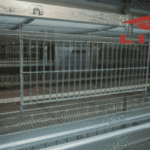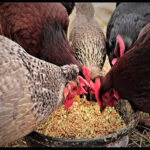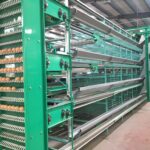Water is the most important nutrient for raising chicken
Water is an important nutrient for life, and the water content of eggs is about 70%. Water can transport nutrients to every tissue of the body to excrete waste in chicken battery cages.
For chickens, in the peak of egg production and high temperature season, water is indispensable. If the water is insufficient, it will seriously affect the digestion and nutrient absorption of the feed, and the body temperature will rise, which will eventually lead to a decline in the performance of the flock. If laying hens are cut off for 24 hours, the egg production rate will drop by 30%; when the chicks are cut off for 10 to 12 hours, the feed intake will decrease and affect their growth. And if the chicken loses 10% of water, it will cause death. The water requirement of chicken varies with season, age and egg production level. When the egg production rate is high, the water consumption increases. When the ambient temperature is higher than 26-27 °C, the water consumption also increases. When the temperature is lower than 14.5 °C, the drinking water The amount is reduced. When the temperature reaches above 35 °C, the amount of drinking water is more than four times that of the feed intake. Therefore, the laying hen should be fully supplied with drinking water during the peak period of egg production and hot season.

Water is the most important nutrient component of chicken, and it is also one of the most easily overlooked nutrients. In feeding and management, it only pays attention to feed nutrition, feed consumption, egg production rate, temperature, ventilation, light, death, etc. Pay attention to water quality and water consumption. Regarding water quality, there are many factors that affect it. It is important to pollute the bacteria. Any water that is used for drinking chicken must meet the standards for water use. In order to make the drinking water clean and hygienic, disinfectants can be often put into the drinking water to kill pathogenic microorganisms in the drinking water. The drinking water of chickens is not balanced during the day. The laying water of the laying hens is the most. The second drinking water peak is before the end of the light. The two drinking water peaks account for about 75% of the total drinking water. The lO–I l point and the 18-20 o’clock afternoon have the most drinking water. According to the drinking water law of the laying hen, the water should be fully supplied at the peak of drinking water.
In short, water is an important and easily overlooked nutrient. At all times, the flock must supply clean and non-polluting water and give plenty of water. In the hot season, the water temperature should not be higher than the temperature. Maintaining 25 ° C, the water temperature in the harsh winter can not be too low, should be maintained above 13 ° C, the use of nipple drinker drinking water is the most hygienic, but also save water, in the production of chicken, in addition to pay attention to normal feeding management, should pay more attention to Drinking water management, scientific and rational drinking water management.












